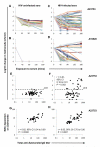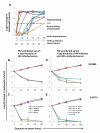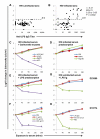Dysregulated humoral immunity to nontyphoidal Salmonella in HIV-infected African adults
- PMID: 20413503
- PMCID: PMC3772309
- DOI: 10.1126/science.1180346
Dysregulated humoral immunity to nontyphoidal Salmonella in HIV-infected African adults
Abstract
Nontyphoidal Salmonellae are a major cause of life-threatening bacteremia among HIV-infected individuals. Although cell-mediated immunity controls intracellular infection, antibodies protect against Salmonella bacteremia. We report that high-titer antibodies specific for Salmonella lipopolysaccharide (LPS) are associated with a lack of Salmonella-killing in HIV-infected African adults. Killing was restored by genetically shortening LPS from the target Salmonella or removing LPS-specific antibodies from serum. Complement-mediated killing of Salmonella by healthy serum is shown to be induced specifically by antibodies against outer membrane proteins. This killing is lost when excess antibody against Salmonella LPS is added. Thus, our study indicates that impaired immunity against nontyphoidal Salmonella bacteremia in HIV infection results from excess inhibitory antibodies against Salmonella LPS, whereas serum killing of Salmonella is induced by antibodies against outer membrane proteins.
Figures




Comment in
-
Immunology. Salmonella susceptibility.Science. 2010 Apr 23;328(5977):439-40. doi: 10.1126/science.1189088. Science. 2010. PMID: 20413482 No abstract available.
-
Dysregulated humoral immunity in HIV infection.Immunotherapy. 2010 Jul;2(4):443-4. Immunotherapy. 2010. PMID: 20648976 No abstract available.
Similar articles
-
Immunology. Salmonella susceptibility.Science. 2010 Apr 23;328(5977):439-40. doi: 10.1126/science.1189088. Science. 2010. PMID: 20413482 No abstract available.
-
Bactericidal Immunity to Salmonella in Africans and Mechanisms Causing Its Failure in HIV Infection.PLoS Negl Trop Dis. 2016 Apr 8;10(4):e0004604. doi: 10.1371/journal.pntd.0004604. eCollection 2016 Apr. PLoS Negl Trop Dis. 2016. PMID: 27057743 Free PMC article.
-
IgG Responses to Porins and Lipopolysaccharide within an Outer Membrane-Based Vaccine against Nontyphoidal Salmonella Develop at Discordant Rates.mBio. 2018 Mar 6;9(2):e02379-17. doi: 10.1128/mBio.02379-17. mBio. 2018. PMID: 29511082 Free PMC article.
-
Hypothesis for vaccine development: protective immunity to enteric diseases caused by nontyphoidal salmonellae and shigellae may be conferred by serum IgG antibodies to the O-specific polysaccharide of their lipopolysaccharides.Clin Infect Dis. 1992 Aug;15(2):346-61. doi: 10.1093/clinids/15.2.346. Clin Infect Dis. 1992. PMID: 1381621 Review.
-
[Cellular immunity in salmonelloses].Zh Mikrobiol Epidemiol Immunobiol. 1977 Jun;(6):11-8. Zh Mikrobiol Epidemiol Immunobiol. 1977. PMID: 331773 Review. Russian. No abstract available.
Cited by
-
Antimicrobial resistance and management of invasive Salmonella disease.Vaccine. 2015 Jun 19;33 Suppl 3(0 3):C21-9. doi: 10.1016/j.vaccine.2015.03.102. Epub 2015 Apr 23. Vaccine. 2015. PMID: 25912288 Free PMC article. Review.
-
Peroral ciprofloxacin therapy impairs the generation of a protective immune response in a mouse model for Salmonella enterica serovar Typhimurium diarrhea, while parenteral ceftriaxone therapy does not.Antimicrob Agents Chemother. 2012 May;56(5):2295-304. doi: 10.1128/AAC.05819-11. Epub 2012 Feb 21. Antimicrob Agents Chemother. 2012. PMID: 22354292 Free PMC article.
-
Cutting edge: B cells are essential for protective immunity against Salmonella independent of antibody secretion.J Immunol. 2012 Dec 15;189(12):5503-7. doi: 10.4049/jimmunol.1201413. Epub 2012 Nov 12. J Immunol. 2012. PMID: 23150714 Free PMC article.
-
Characterization of the Invasive, Multidrug Resistant Non-typhoidal Salmonella Strain D23580 in a Murine Model of Infection.PLoS Negl Trop Dis. 2015 Jun 19;9(6):e0003839. doi: 10.1371/journal.pntd.0003839. eCollection 2015 Jun. PLoS Negl Trop Dis. 2015. PMID: 26091096 Free PMC article.
-
Effect of human immunodeficiency virus infection on plasma bactericidal activity against Salmonella enterica serovar Typhimurium.Clin Vaccine Immunol. 2014 Oct;21(10):1437-42. doi: 10.1128/CVI.00501-14. Epub 2014 Aug 13. Clin Vaccine Immunol. 2014. PMID: 25121777 Free PMC article.
References
-
- Clumeck N, Mascart-Lemone F, de Maubeuge J, Brenez D, Marcelis L. Lancet. 1983;1:642. - PubMed
-
- Jacobs JL, Gold JW, Murray HW, Roberts RB, Armstrong D. Ann. Intern. Med. 1985;102:186. - PubMed
-
- Levine WC, Buehler JW, Bean NH, Tauxe RV. J. Infect. Dis. 1991;164:81. - PubMed
-
- Gruenewald R, Blum S, Chan J. Clin. Infect. Dis. 1994;18:358. - PubMed
-
- Gordon MA, et al. Clin. Infect. Dis. 2008;46:963. - PubMed
Publication types
MeSH terms
Substances
Grants and funding
LinkOut - more resources
Full Text Sources
Other Literature Sources
Medical

